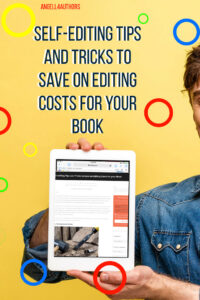This post was updated on August 29th, 2023
Hello Lovelies,
Editing. The hardest part of being an author. By FAR! And the place where you will find the most scammers out there to make a quick buck. Seriously, there isn’t a site I’ve been to that doesn’t have tons of people peddling questionable skills to authors. I have seen so many authors get badly burned because they hired sub-par editors, or hire top-notch editors (who are worth a pretty penny!) without having done any self-editing of their book and end up paying through the nose.
So, let’s talk about each step of editing and some free ways to address it so your editor spends less time doing the work, and in turn will charge you less! If you are traditionally published by one of the big houses, your book will go through several editors before it goes to print. There’s a process, much like sanding, and if you do not get each step, then you are missing out. While you can go back and forth between steps, step two cannot truly be done until step one is finished, and step three cannot truly be done until step two is finished.
As we review each step, I will share what an editor does for that step, and things you can do to self-edit your book before sending it to that type of editor that will help save you money.
Step 1. Developmental Editing

The first step is general editing. (Also called content editing, revisions, story editing, developmental editing, substantive editing, rewrites, etc.). This is where the editor goes through the story and catches plot holes, recommends what needs to be cut, re-written, added, etc. This is where character development and motivations are analyzed, where genre tropes are explored. It is carving your vision from the rough wood, or refining the best of the story.
How can you save money on an editor for this step?
After you hit “the end”, shelf your book for a few days or weeks, then start fresh reading it focusing specifically on story development. If you find issues, address them. Rinse and repeat until you are able to finish without any changes being made. But you can probably see a host of reasons why this is not ideal. One, you can only fix what you know to fix. Two, it is very time-consuming. Three, you know things about your character and the story that maybe never made it to paper but you have it in your brain and even with time off, those elements may still impact your ability to see just the story as it is written.
I personally do this developmental self-editing step for all of my books, in two ways. First, I re-read what I wrote my last session to get me back in the groove for my writing session. As I am reading it, I can catch obvious issues. Then, once the manuscript is done, I put it away for a week and then do a full read on a weekend when I don’t have anything else planned. I find the longer I give my “memory” to reflect on the story, the less likely I am to catch issues so a quick read-through works best for me. Then, rather than shelving and going for a 2nd go in another week, I will actually do the 2nd option for self-editing.
A second option that is very helpful is to get someone who isn’t an editor to do a read-through with some guidelines. A lot of authors work in peer groups and this is a great (usually free) resource. Others use Alpha readers. This is a good place to have your mom, or cousin, or friend read through and point out issues in the story. If you aren’t working with a professional group, (or even if you are, depending on the quality of the group) you want to send a list of questions to your alpha reader to answer as they review so that they know what to look for. Here’s my favorite Developmental self-editing checklist, and I post it at the beginning with a thank you note, and then add it to the end of each chapter, to encourage regular commentary. (FYI, I totally use this list during my own pass-through. It is that handy!)
For the reviewer: Please provide responses to at least five of the questions below:
- Is the writing clear? (Did the author provide the key info regarding tense, POV, and use of language to enable you to follow their writing with ease?)
- Can you visualize the settings and characters? Is there too little or too much description?
- Does the story flow well in terms of time, POV, setting – or does it jump from scene to scene?
- Are the characters believable for their age, occupation, time period?
- Is the dialogue natural or forced? Is any dialect easy to follow or does it distract you from your reading?
- Are there too many or not enough dialogue/action tags? Can you follow the conversations easily?
- Are there any sections you skipped? Why?
- Are you confused by any parts of the story?
- Did you feel the emotion of the story? Were you drawn into the character’s world?
- Is there enough intrigue, conflict, tension, emotional pull to make you want to read on?
Feel free to comment on other aspects such as voice, style, use of language, character development, structure …and so on.
Thank you,
When using non-fiction alpha readers or peer groups to review your work, it’s important to provide them with specific guidelines and questions to help them provide valuable feedback. Here’s a list of questions tailored for reviewing non-fiction works:
Content and Clarity:
-
Thesis and Main Points: Is the main thesis or purpose of the work clear? Can you identify the main points or arguments?
-
Organization: Is the content logically organized and easy to follow? Are there clear transitions between sections and ideas?
-
Audience: Does the content effectively target its intended audience? Is the tone and level of complexity appropriate?
-
Coherency: Do the ideas flow smoothly? Is there a consistent thread that ties the content together?
-
Clarity: Are the concepts explained clearly? Are there any areas that could be confusing or need further clarification?
Accuracy and Credibility:
-
Factual Accuracy: Are the facts, data, and references accurate? Are there any factual errors or misinterpretations?
-
Credibility: Is the author’s expertise on the subject evident? Is there enough supporting evidence to back up claims?
-
References and Citations: Are the sources properly cited? Are there missing citations or references that should be included?
Engagement and Readability:
-
Engagement: Does the content capture your interest and keep you engaged? Are there parts that feel dull or uninteresting?
-
Examples and Illustrations: Are the examples and illustrations effective in conveying the points being made?
-
Language and Style: Is the writing style appropriate for the subject matter and audience? Is the language clear and concise?
Completeness and Depth:
-
Depth of Coverage: Does the content cover the topic comprehensively? Are there areas that need more in-depth exploration?
-
Completeness: Are there any gaps in the information provided? Are there topics or subtopics that should be included but are missing?
Actionability and Takeaways:
-
Actionable Information: Does the work provide actionable insights or practical takeaways for the reader?
-
Application: Can readers apply the information in real-life scenarios? Are there clear recommendations or suggestions?
-
Impact: Does the content have the potential to make a meaningful impact on the reader’s understanding or behavior?
Overall Impressions:
-
Overall Effectiveness: Based on your reading, how effective is the piece in achieving its goals? What are its strengths and weaknesses?
-
Unique Contributions: Does the work offer a unique perspective or insights that set it apart from other similar works?
Remember, it’s also helpful to encourage your alpha readers to provide specific examples or references to support their feedback. Tailor these questions to the specific nature and focus of your non-fiction work, and feel free to add any additional questions that are relevant to your content. This kind of guided feedback can greatly assist in improving the quality and impact of your non-fiction writing.
The struggle of crowd-sourcing this step is that:
- It can be time-consuming.
- You cannot guarantee the quality of the responses you will get.
- You risk your work getting exposed before it is ready.
I make sure for this step that I am using people I really trust, and I keep the group small (Ideally at least 3, never more than 9) and they all sign an NDA (non-disclosure agreement). You will still want to make sure that the editor you hire will also cover this, but your goal is that there will be very little work required at this step so that they don’t have to take as much time covering it and what time is spent on it is taking your good book to make it GRRRREAT!
I’ll be honest, when I quote line editing projects, if I see a lot of content issues, I won’t even offer a line editing bid. I will recommend that they submit a developmental editing sample so I can give them a quote on that. I have seen books where they clearly hodge-podged different editors and the editors didn’t make recommendations they just made changes, so each section is inconsistent and it is sad. On the other hand, while I am doing line edits if I catch dev edit issues I will mark them as well.
Another thing that I do, which I think is unique. I always provide links to additional content when I make recommendations. I am a teacher first, and an editor second.
Want to get a free Developmental Edit quote?
Step 2. Line Editing
Also referred to as copyediting, stylistic editing, second edits, or for lazy editors “editing”. This is where the shape of the story gets more cleanly refined. The rough sanding to pull out the general form you created, gradually getting finer until your woodworking project has come to life….. er, your story. Right, we’re talking about editing!

The editor will go line by line to make sure the sentence structure is correct, the grammar is correct, and the meaning is clearly conveyed. They will recommend word changes, writing in active voice, or removing sentences that are repeating information.
9 times out of 10, when you get an editor who says they “provide editing services” without breaking those down, this is what they are referring to and unless you clarify, you will get nothing more. There are some clever tools that you can use to self-edit your book for the editor so that they don’t have as much work to do (and in my case, will charge you less) such as ProWritingAid and Grammarly.
However, one of the concerns I have about these tools is that they are only as useful as the hands that wield them. Grammarly is great for technical writing and online copy, but it doesn’t take into account stylistic choices that are seen in many works of fiction. ProWritingAid is a bit better, in that it actually analyzes your text, makes a note of where words are overused, and makes stylistic recommendations, but it’s not skilled at specific genres. Both tools are better than nothing, but just like with Word, you still need to know enough to make the right choice in the end. After you run through these programs, you still want to hire an editor, but as you get the hang of it, these programs are great because they will help you write better as you learn the skills. Then you will find that the cost of an editor will drop significantly.
Just as with dev edits, when I am editing for a client I will cite resources that explain the rules. I always use track changes or suggestion mode because, at the end of the day, your work is your work so it is up to you which rules to follow and which to ignore.
For clients on a tight budget, I also offer my line edits chapter by chapter so as you learn things from the previous chapter you can incorporate them throughout the rest of the work before me and save yourself even more money.
Want a free Line Edit quote?
The Final step: Proofreading
The final step is proofreading. The internet has LOTS of differing opinions on exactly what proofreading entails. The gist is that proofreading is a last read-through to catch any final errors. A lot of editors do this pre-layout, but in my humble opinion (and in traditional publishing) it should be done after layout (and in each format you are publishing in) to catch any missed bits. The benefit to doing this after you complete the layout is that the proofreader can look at the product as if they were a customer. They can catch not only misspellings, homonyms, and punctuation; they can also “double-check” layout. Consider it a final buff, polish, and seal on your project to make it as shiny and appealing as possible.

Having someone who can catch all the writerly bits as well as spotting funky layouts on the page, such as widows and orphans, and the general appeal of the final product will allow you to produce the best final version possible. If you are tight on budget, Beta Readers are a great tool for proofreading. I would choose 5 top readers, and provide them with instructions on what you are looking for and how to notate it.
If you are sending them a post-layout copy (as you should), ask them to keep a running journal and note the version they are reviewing. (E-pub, PDF, Paperback, Mobi, etc.) Then have them track the errors as such: chapter/page number the error occurs, paragraph number, sentence number, and what the error is.
Easy, peasy.
Want a proofreading quote?
Final Thoughts Before Hiring an Editor
I work as an editor in fiction and non-fiction. I have published or worked on over 100 hundred books in my career, and written and published over a baker’s dozen of my own. After 20 years of experience, I still hire an editor for my own work. I have actually had people question my editing skills for this. But the reality is any editor who is also a writer will tell you that they do the same thing. We all have blind spots. We all know what we mean to say and so even when using tricks like “read it aloud sentence by sentence from end to beginning” to catch line errors, some slip through because our brain cannot be tricked.
Some would say “Eh, but it is better than what a lot of others are producing. I see errors in traditionally published books. Surely, you can give yourself a pass?” Except I don’t want to produce better. I want to produce great. And don’t call me Shirley! (Blame my husband for that horrible pop culture reference!)
I strongly recommend that an author gets as many eyes on a project as possible before going to publication and I live by my advice. No book can ever be perfect. But the goal is to have it as perfect as possible.

I do provide all three forms of editing services, but I will not provide all at the same time. Although you can hire me for all three, I will only accept such contracts for all three if the author has utilized other resources (such as the ones noted above) and I require two weeks off between stages to “scrub my brain” so to speak. If you have an editor who does offer all three services in “one pass” you should question the quality of those services.
What are your questions about editing?
Are there any free tools you use?
Let us know in the comments below!
Until next time,
Keep Writing!